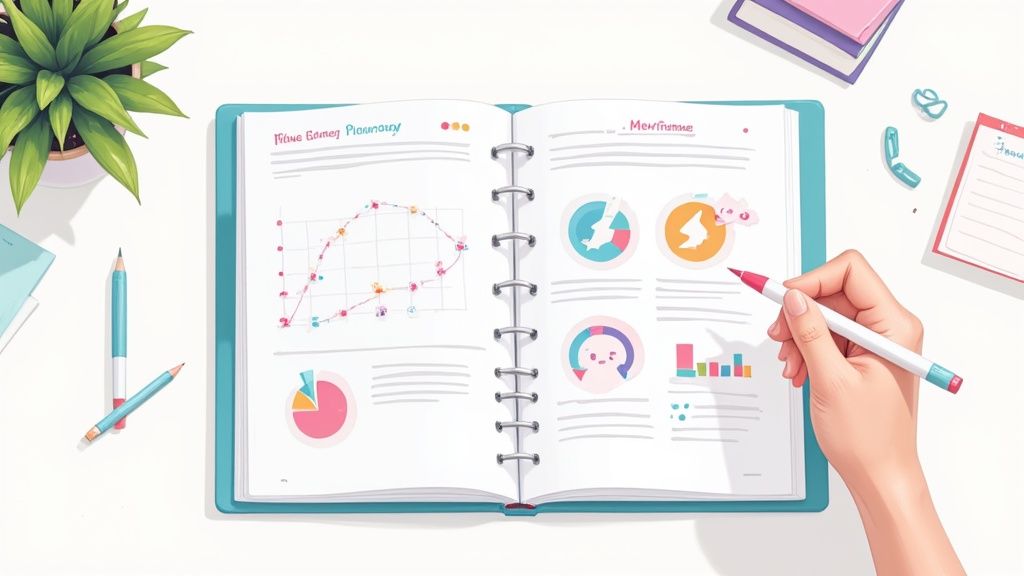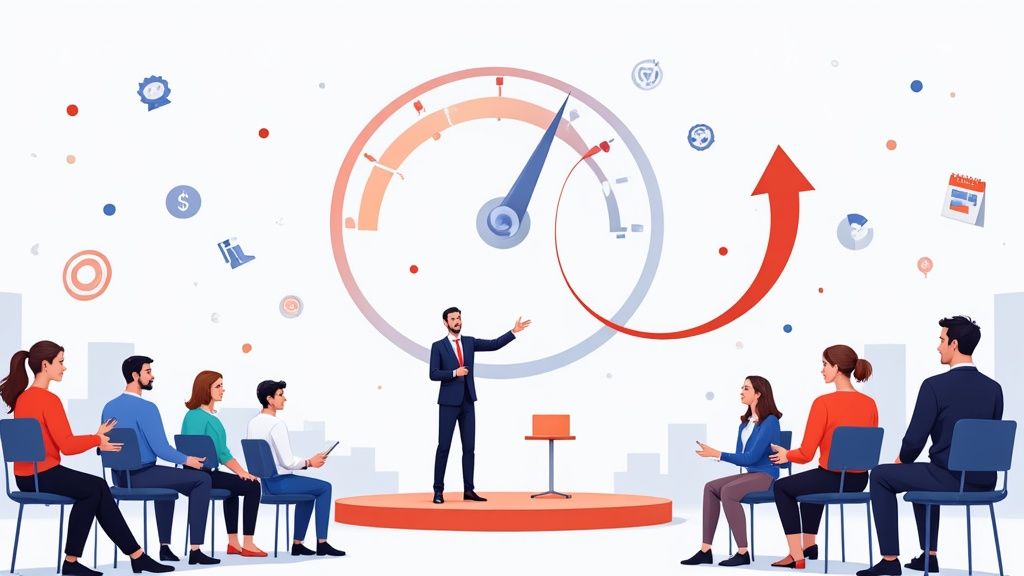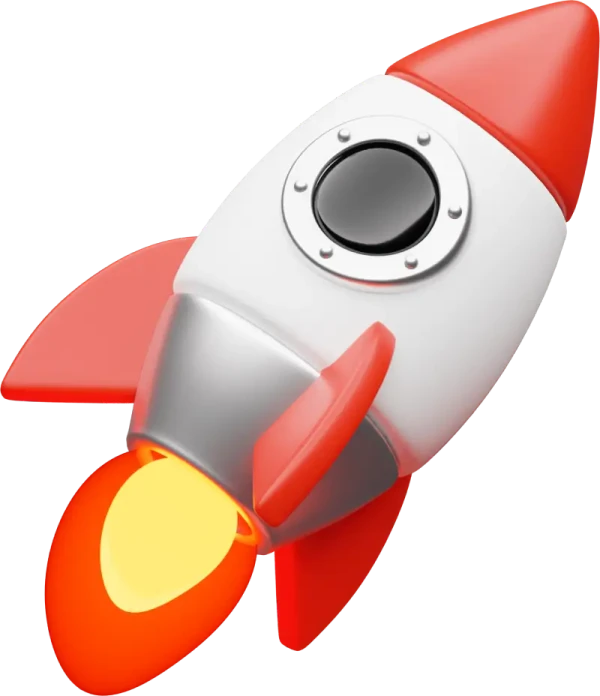Think of an event marketing plan template as your strategic roadmap. It's the document that guides every promotional dollar and every minute you spend toward a successful event. It’s what separates hoping for a full house from having a predictable path to selling out.
Let’s be real: winging it with event marketing is a fast track to budget overruns and a room full of empty chairs.
Why a Plan Is Your Most Valuable Event Asset
Trying to promote an event without a plan is like driving in a new city without GPS. You might get there eventually, but you'll burn through time, gas, and patience making wrong turns. An unstructured approach inevitably leads to last-minute scrambles, missed opportunities, and an inability to show any real return on investment (ROI).
A solid event marketing plan template turns that chaos into clarity. It's more than a simple checklist; it's a strategic guide that gets your team on the same page, locks in your budget, and maps out a clear path to hitting your goals. This is essential whether your event is in-person, fully virtual, or a hybrid of both.
The Growing Need for Strategic Planning
The stakes in the events world have never been higher. The global events industry is expected to explode from roughly $736.8 billion in 2021 to a staggering $2.5 trillion by 2035.
And the professionals on the ground feel it. 66% of event organizers plan to schedule more events in 2025, and 74% expect their budgets to grow right along with them. To handle this scale, 79% of professionals now lean on Event Management Systems (EMS) to keep their planning organized.
These numbers tell a clear story: events are a bigger piece of the business pie. And with bigger budgets comes a greater need for accountability. A plan delivers that.
A great marketing plan is a living document that keeps your entire team focused on the same goals. It's the single source of truth that prevents tasks from falling through the cracks and ensures every action contributes to the bottom line.
From Reactive Scrambles to Proactive Success
Without a plan, your marketing is purely reactive. You post on social media when you remember, send a few sporadic emails, and then panic when ticket sales flatline. It's a stressful and wildly ineffective way to work.
A plan flips the switch to proactive. It forces you to think through every detail, from the first pre-launch teaser to the final post-event follow-up. This forward-thinking approach helps you:
- Align Your Team: Everyone, from marketing and sales to the on-site coordinators, knows their role, what’s due when, and what you’re all working toward.
- Secure and Justify Your Budget: A detailed plan shows stakeholders exactly how you'll use their investment to hit specific, measurable goals.
- Maximize Attendee Engagement: By truly understanding your audience and mapping out their journey, you create marketing that actually connects with them.
- Prove Your Event's Value: The plan establishes the key performance indicators (KPIs) from day one, so you can clearly demonstrate success long after the doors close.
To get a head start, you can use a comprehensive Event Marketing Strategy Template. It gives you a solid foundation to build on, so you aren't starting completely from scratch.
Defining What Success Looks Like for Your Event
Before a single promotional email gets drafted or a social media post goes live, your event marketing plan template needs a north star. This is where you get brutally honest about what a "win" actually looks like. We need to move beyond fuzzy goals like "more attendees" and lock in concrete, measurable business outcomes.
Without clear goals, your marketing efforts are just noise. You need targets that give your entire plan purpose and direction.
From Vague Ideas to Tangible Targets
Instead of just aiming for a "successful conference," you have to define what success means for your business. Is it about feeding your sales pipeline? Is it a pure brand awareness play? Or are you trying to strengthen relationships with your existing customers?
Each of these goals demands a completely different strategic approach.
Let’s look at how to turn those common event goals into specific, powerful objectives you can actually track:
- Lead Generation: Instead of "get leads," aim to acquire 150 new marketing qualified leads (MQLs) with a post-event demo request rate of at least 10%.
- Brand Awareness: Forget "get the word out." Target 500,000 social media impressions using the event hashtag and secure mentions in 3 specific industry publications.
- Partnership Development: Don't just "network." Plan to onboard 3 new channel partners by facilitating strategic networking sessions during the event.
- Customer Retention: Make it concrete. Secure a 90% attendance rate from your top 50 client accounts and aim for an average session rating of 4.5/5 stars.
Setting these targets upfront is everything. It lets you build your marketing strategy backward from the finish line, making sure every single tactic serves a clear purpose.
Building Your Ideal Attendee Persona
Once you know your goals, the next question is obvious: who needs to be in the room (or on the webinar) for you to hit them? This is where you build out a detailed ideal attendee persona. And no, generic demographics like "marketing managers, age 30-45" won't cut it.
A truly useful persona digs into the real motivations, daily challenges, and professional lives of the people you want to attract. When you have this deep understanding, every piece of marketing content you create - from ad copy to blog posts - will speak directly to their needs.
Ask yourself these kinds of questions to build a persona that actually works:
- Professional Role: What’s their job title? More importantly, what are their primary responsibilities and the KPIs they're judged on?
- Core Challenges: What are the biggest professional headaches they face every day? What keeps them up at night?
- Information Sources: Where do they hang out online? Which blogs do they read, podcasts do they listen to, and influencers do they follow?
- Event Motivation: Why would they even come to your event? Are they hunting for new skills, networking opportunities, or a direct solution to a problem they have right now?
Creating a detailed persona isn't just a fluffy marketing exercise; it's a strategic imperative. When you know exactly who you're talking to, you can craft a message that makes them feel seen and understood, which is what compels them to register.
The data backs this up. A massive 83% of marketers see events as a critical part of their company's success. This is mirrored by attendees, as 79% say they're more likely to buy something after attending a live event. For B2B marketers, it’s even more stark, with 94% stating events are essential for building relationships and generating leads. You can dig into more of these event industry insights on momencio.com.
By combining specific, hard-nosed goals with a deep, empathetic understanding of your ideal attendee, you give your event marketing plan real power. You're no longer just "promoting an event" - you're offering a targeted solution to a specific audience. This is also a foundational step if you want to learn more about how to increase event attendance in a meaningful way.
Building Your Pre-Event Promotion Timeline
A killer promotional timeline is the engine that drives your entire event marketing plan. This isn't about firing off a few random emails and crossing your fingers. It’s about creating a sustained drumbeat of excitement that builds momentum - from the very first announcement all the way to that final 48-hour push.
A well-built timeline transforms your strategy into a series of perfectly timed actions, guiding potential attendees from "What's this?" to "I'm in!"
Momentum is everything here. You want to build anticipation layer by layer, weaving together email, social media, content, and partnerships into one cohesive story that keeps your event top-of-mind.
Of course, before you map out a single post or email, you need to know exactly who you're talking to. The first step is always understanding your audience - their demographics, their motivations, and what makes them tick.
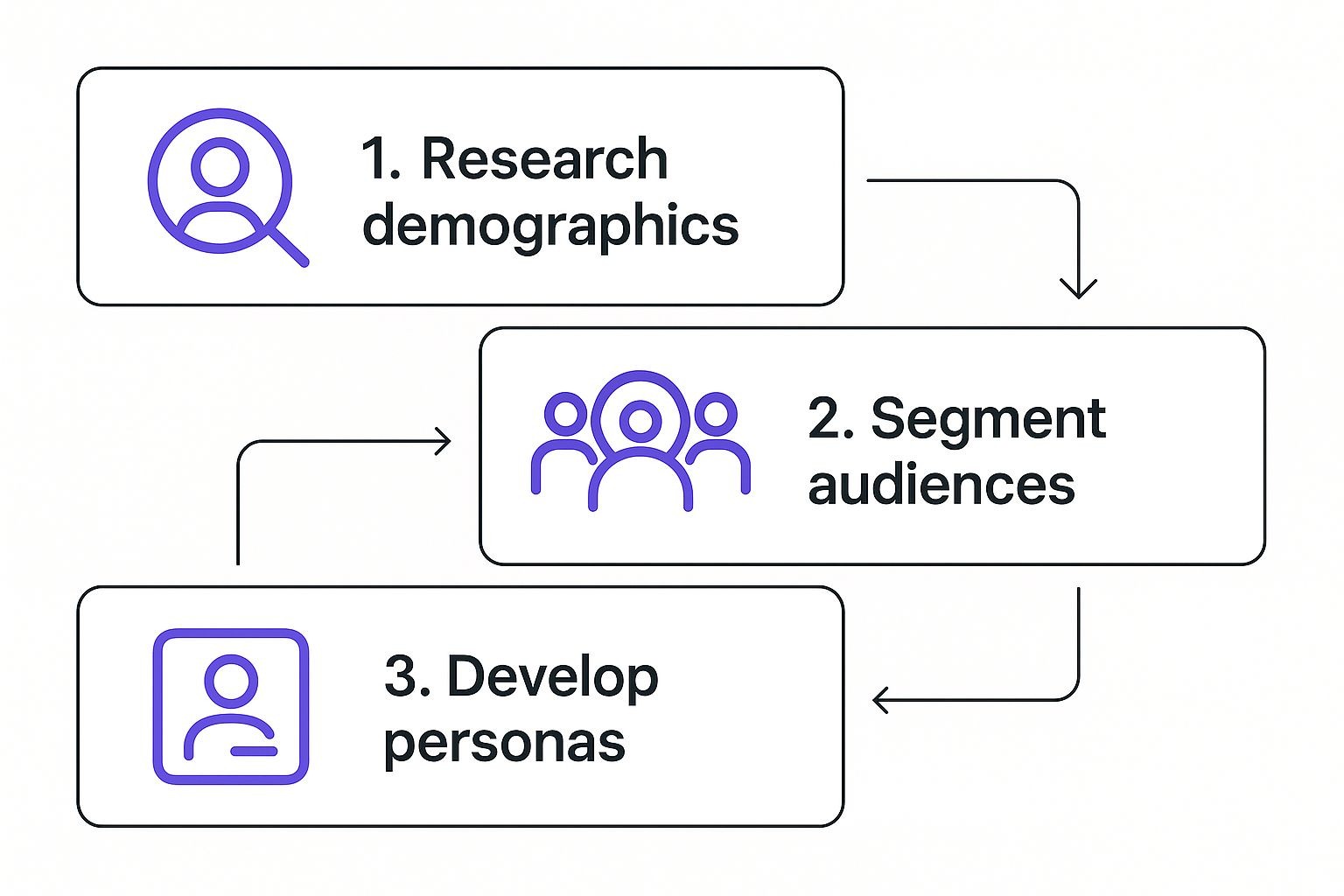
When you know your audience inside and out, every piece of promotion you create will hit the mark.
The 16-Week Kickoff Phase
Believe it or not, your promotion should kick off long before you expect the first ticket sale. This early phase, starting roughly four months out, is all about laying the groundwork and generating that initial buzz. The focus is purely on awareness and establishing your event's credibility.
- Content Foundation: Start publishing blog posts and articles that align with your event's core themes. Think about an interview with a keynote speaker or a deep-dive article on a key industry trend. This positions you as a valuable source of knowledge from day one.
- Initial Announcement: Get your event website and registration page live. This is your central hub for everything, so make sure it's polished and professional right from the get-go.
- Early Bird Campaign: Craft your first email sequence announcing the event. The star of the show? A significant early-bird discount with a clear, urgent call-to-action that emphasizes the limited-time offer.
The goal of the kickoff phase isn’t to sell out; it's to plant the seed. You want to capture the attention of the most eager members of your audience and build a base of early registrants who can act as social proof later on.
The 8-Week Acceleration Phase
With two months to go, it's time to turn up the volume. Your marketing should shift from broad awareness to more targeted, conversion-focused efforts. You've established the "what," and now it's time to really hammer home the "why."
This is when you start layering in different tactics and channels. If you need a spark of creativity, this list of unique event promotion ideas is a great place to find tactics you can weave into your plan.
Here's what your focus should look like during this critical period:
- Speaker & Sponsor Spotlight: Use your social media and email newsletters to shine a light on individual speakers, sponsors, and can't-miss sessions. Share punchy quotes, short video clips, or key takeaways to show off the incredible value attendees will get.
- Influencer & Partner Outreach: Time to activate your network. Equip your sponsors, speakers, and friendly industry influencers with a pre-made marketing kit. This should include sample social media copy, branded graphics, and a unique tracking link so they can easily share the event with their own followers.
- Paid Advertising: Launch targeted ad campaigns where your audience actually hangs out. Think LinkedIn for a B2B conference or Instagram for a consumer-focused festival. Use those detailed personas you built to write ad copy that speaks directly to their needs and pain points.
The Final 2-Week Countdown
The last two weeks are an all-out sprint to the finish line. At this point, urgency is your most powerful marketing tool. Your messaging needs to be direct, frequent, and laser-focused on one thing: driving those last-minute registrations.
This final push is about creating an unmissable sense of FOMO (fear of missing out). Every detail matters, even the small physical touchpoints. For a closer look at how tangible items can play a role, you might find some interesting ideas in an ultimate strategy guide for promotional marketing pens and similar resources. It’s all about making your event feel like the only place to be.
Mastering Your Event Budget and Tech Stack

Even the most brilliant event marketing plan can fall flat without two things: a solid budget and the right tech. Get these wrong, and you're in for a world of pain. A bad budget calculation can gut your promotions, and clunky tech creates a nightmare for you and your attendees.
Let's break down these two make-or-break elements. First, we'll tackle how to build a budget that actually works. Then, we'll get into choosing a tech stack that makes your life easier, not harder.
Building Your Event Budget
Think of your budget as more than just a spreadsheet of expenses. It’s a strategic roadmap that shows what you truly care about for this event. Before you can even think about spending, you need a firm grasp on your potential revenue - ticket sales, sponsorships, maybe even merch. This number is your starting line.
Once you know what you can spend, it's time to slice the pie. Each piece represents a major spending category, and your job is to make sure the slices are proportional. If you blow most of your budget on a swanky venue, you might be left with an empty, expensive room because you had nothing left for marketing.
Your budget is the financial expression of your event's strategy. How you allocate funds directly shows what you value most - whether it's the speaker lineup, the attendee experience, or the marketing reach.
So, how does this look in practice? While every event is different, here’s a sample breakdown that serves as a fantastic starting point for a typical corporate conference or trade show.
Sample Event Budget Allocation
This table provides a realistic framework for allocating your funds. It’s not set in stone, but it’s a great way to ensure you're not over-indexing in one area at the expense of another.
| Budget Category | Recommended Allocation (%) | Example Line Items |
|---|---|---|
| Venue & Catering | 25% - 35% | Rental fees, food and beverage, AV equipment, security, insurance |
| Marketing & Promotion | 15% - 25% | Paid ads, social media campaigns, email marketing, content, PR |
| Speakers & Talent | 10% - 20% | Speaker fees, travel expenses, accommodation, honorariums |
| Technology Stack | 10% - 15% | Registration platform, event app, virtual streaming software, CRM |
| On-Site Experience | 5% - 10% | Signage, swag bags, name badges, decor, entertainment |
| Contingency Fund | 5% - 10% | An essential buffer for unexpected costs and emergencies |
Remember to always leave that 5-10% contingency fund. Trust me, something unexpected always comes up.
A final tip: don't be afraid to negotiate. Vendors, especially venues, often have wiggle room in their pricing, especially if you’re booking during an off-peak season. And always ask about bundled packages - you can often save a good chunk of change.
Selecting the Right Technology Stack
Your event tech is the digital nervous system of your entire operation. The goal is simple: create a buttery-smooth experience for attendees, from the moment they hit your registration page to the post-event survey. The wrong tools create friction; the right ones make it all feel effortless.
I find it helps to map out the entire attendee journey and pinpoint where tech can make a real difference.
- Discovery & Registration: This is your first impression. Your event website and registration software need to look good, work on a phone, and be dead simple to use. A confusing registration process is the quickest way to lose someone.
- Pre-Event Engagement: This is where an event app or an automated email system shines. You can send push notifications about new speakers or targeted emails with session suggestions based on an attendee's profile.
- During the Event (Live, Virtual, or Hybrid): For live events, a good app is your best friend - think interactive maps and easy networking tools. For virtual events, your streaming platform is the event. It absolutely has to be reliable.
- Post-Event Follow-Up: This is where the magic happens for your business goals. When your event platform talks to your CRM, you can easily track leads, measure who engaged with what, and actually prove your event’s ROI.
When you're looking at different platforms, it's easy to get mesmerized by a long list of features. Don't fall for it. Focus on what you actually need. A small company hosting a simple webinar doesn't need the same beast of a platform as a massive international conference.
Make a checklist based on your specific goals and budget. Choose the tools that check the most important boxes for your event. That way, every dollar you spend on tech is directly tied to a better experience and a stronger business outcome.
Proving Your Event's Value After It Ends
The lights dim, the last attendee heads home, but your work isn't over. In fact, this is where some of the most critical work for your event marketing plan begins. The post-event phase is your chance to turn a great experience into tangible, measurable business results.
This is the moment you connect all the dots, proving the value of every dollar and hour you poured into the event. Your focus pivots from promotion to proof. It’s far more than just sending a generic "thank you" email; it's a strategic process of follow-up, analysis, and reporting that justifies the event's existence and paves the way for the next one.
Measuring What Truly Matters
To prove your event was worth it, you have to track the key performance indicators (KPIs) that tie directly back to the goals you set from the very beginning. Vague metrics won't cut it with stakeholders - you need hard data.
Focus on a mix of metrics that tell the complete story:
- Registration-to-Attendee Conversion Rate: This is a big one. It shows how many people who signed up actually showed up. A low number here could signal a problem with your pre-event communication or a disconnect with what your audience really wanted.
- Cost Per Lead (CPL): A straightforward ROI metric. Just divide your total event spend by the number of qualified leads you generated. This tells you exactly how efficient your event was at bringing in new prospects.
- Pipeline Influence: This is absolutely essential for B2B events. You need to track how many leads from the event made it into your sales pipeline and, more importantly, how much potential revenue they represent.
- Social Media Sentiment & Engagement: Don't forget to analyze the post-event chatter online. Were people saying positive things? Did your event hashtag keep getting used? This is how you measure the lasting brand buzz.
Your post-event report isn't just a formality; it's a powerful narrative. It uses data to tell the story of how your event impacted the business, from building brand love to directly influencing sales revenue.
Crafting a Strategic Follow-Up Plan
A generic "thanks for coming" email is a massive missed opportunity. Your follow-up needs to be just as strategic as your pre-event promotion. The key is segmentation - delivering the right message to the right person based on their actions.
Here’s a practical way to think about your follow-up sequence:
- Immediate Value (Within 24 Hours): Get an email out to all attendees with links to session recordings, presentation slides, or a photo gallery. This gives them instant value and keeps the good vibes going.
- Segmented Nurture Streams (2-3 Days Post-Event): Now it's time to get smart. Split your attendee list into different groups. For instance, "Hot Leads" who visited your booth or asked for a demo should get a personal follow-up from a sales rep. "Engaged Attendees" who went to multiple sessions can be added to a nurture sequence with deeper content on those topics.
- The Feedback Loop (1 Week Post-Event): Send out a short, simple survey to get crucial feedback. Ask about their favorite sessions, the overall experience, and what they'd love to see next year. This feedback is absolute gold for planning your future events.
This kind of targeted approach ensures you continue the conversation you started, guiding leads down the funnel without being pushy. To truly nail this part and show the impact of your efforts, it's worth learning more about unlocking event ROI metrics success.
By focusing on meticulous tracking and a smart, segmented follow-up, you close the loop on your event marketing plan. For more insights on this topic, check out our deep dive into event marketing for events. You'll transform a one-time gathering into a powerful engine for long-term growth and prove its undeniable value to your entire organization.
Answering Your Top Event Planning Questions
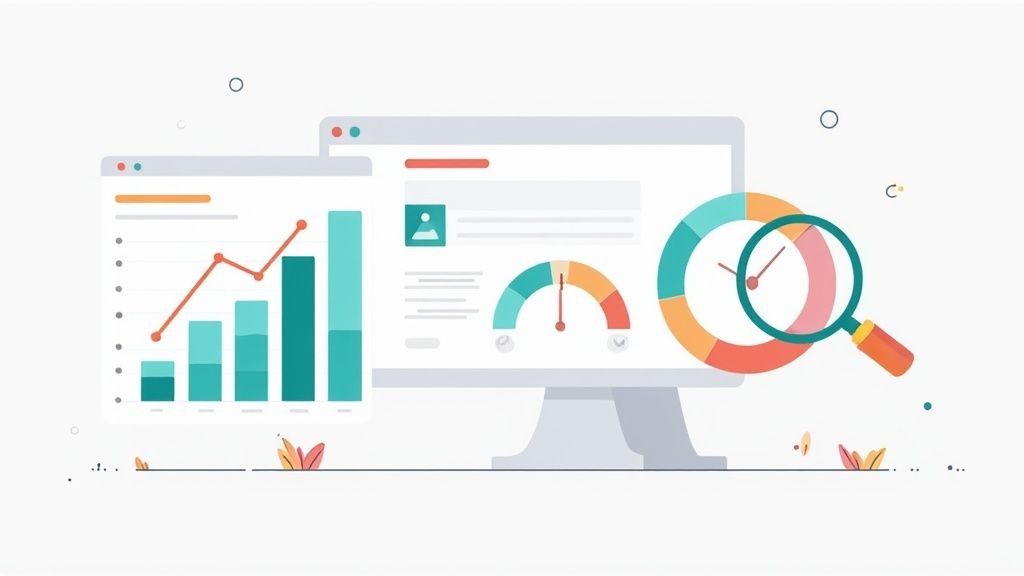
Even with the slickest event marketing plan template, questions are going to pop up. That’s just part of the game. Having been in the trenches ourselves, we've pulled together the most common questions we get from fellow event marketers. Here are some straight-up answers to help you navigate the tricky spots.
How Far in Advance Should I Start Marketing My Event?
I wish there was a magic number, but the honest answer is: it depends. The best approach is always to work backward from your event date, and the scale of your event is what really dictates the timeline.
If you're planning a massive conference with over 500 attendees, you need a long runway. I'm talking 6-8 months out to really get the marketing engine humming. This gives you enough breathing room for all the critical phases - building a compelling early-bird offer, creating a steady stream of valuable content, and locking in media or influencer partnerships without that last-minute panic.
For a smaller, more focused event like a workshop or a weekly webinar, a tighter timeline is actually better. A 6-8 week promotional window usually hits the sweet spot. It's long enough to build awareness and drive sign-ups but short enough to maintain a real sense of urgency.
Whatever you do, map this timeline out in your event marketing plan. This forces you to create distinct phases for awareness, consideration, and decision-making, so you can avoid that dreaded final scramble for registrations.
Which Marketing Channels Deliver the Best Results for Events?
The best channels are always going to be where your target audience actually hangs out. But time and again, a winning strategy comes down to a smart mix of email, social media, and content marketing.
Think of it as a three-legged stool for your promotion:
- Email Marketing: This is your absolute workhorse. Nothing beats email for direct conversions, segmented messaging, and nurturing leads. It's your direct line to your most engaged people.
- Social Media: Here, the specific platform is everything. For B2B events, LinkedIn is a goldmine for targeting specific industries and job titles. For B2C events, platforms like Instagram and Facebook are fantastic for creating visual buzz and tapping into community features.
- Content & Partner Marketing: Don’t sleep on the power of good content. Blog posts that feature your speakers or dig into your event's themes build authority and pull in valuable organic search traffic. Even better, getting your speakers and sponsors to share with their networks is one of the most powerful ways to expand your reach authentically.
When you integrate these channels, you create a promotional ecosystem where each part lifts the others, delivering far better results than any single channel could alone.
I’ve learned from experience that the most effective channel is often the one you co-create. A joint webinar with a sponsor or a guest blog post on a speaker's site almost always outperforms a standard paid ad because it comes with built-in trust and credibility.
How Do I Actually Measure Event Marketing ROI?
Measuring real event ROI means looking way beyond ticket sales. The basic formula is simple enough - (Total Gain - Total Cost) / Total Cost - but the real work is in defining and tracking the "gain."
To get the full picture, you need to be tracking metrics that tell the whole story. This includes things like the total pipeline value generated from event leads, the customer acquisition cost (CAC) for new customers who signed up, and even attendee engagement scores from your event app. These data points paint a much richer picture of success.
The single most critical piece of the puzzle? Making sure your event tech is integrated with your Customer Relationship Management (CRM) system. Seriously, this is non-negotiable for proper ROI tracking.
This integration lets you follow an attendee's entire journey - from their first touchpoint (maybe a social ad), to their registration, to their session attendance, and finally, to when they become a paying customer. This closed-loop reporting gives you a clear, undeniable picture of your event's total financial impact.
What Should My Post-Event Follow-Up Strategy Look Like?
A generic, one-size-fits-all "thank you" email is a huge missed opportunity. Your follow-up has to be strategic and, most importantly, segmented. Sending the same message to a hot lead who requested a demo and a casual attendee who just watched one session is just plain ineffective.
Your follow-up should happen in stages:
- Immediate Value (Within 24 Hours): Every single attendee should get an email packed with immediate value. This is the perfect time to share session recordings, presentation slides, or other exclusive content you promised.
- Hot Lead Handoff (Immediate): Hot leads - like someone who requested a demo at your booth - need a different touch. They should get a personal email from a sales rep almost instantly. Speed is everything here.
- Segmented Nurture Sequences (Days 2-10): Everyone else can be dropped into an automated nurture sequence. Segment these lists based on behavior. For instance, people who watched all your data science sessions could get a follow-up series with deeper content on that very topic.
The whole point is to thoughtfully continue the conversation you started at the event, not just let it die. A smart follow-up process is what turns one-time attendees into loyal, long-term customers.
Elevate your event marketing from start to finish with Add to Calendar PRO. Our platform gives you the tools to create seamless Add to Calendar buttons, manage RSVPs effortlessly, and build beautiful, shareable event pages that get noticed. Simplify your workflow and amplify your reach by visiting https://add-to-calendar-pro.com to learn more.
